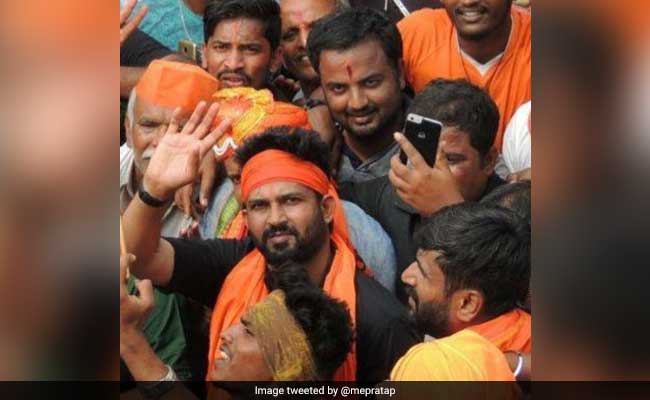In a shocking revelation following the recent security breach in the Lok Sabha, it has been disclosed that the Attackers who accessed the chamber through the visitors’ gallery reportedly obtained passes from the office of BJP MP Prathap Simha. Members of Parliament emphasized that visitors normally undergo a stringent five-level security clearance process and require the approval of an MP’s office for a pass to the visitors’ gallery.
The breach, reminiscent of the 2001 attack on Parliament, unfolded when two individuals carrying smoke canisters leaped into the House from the visitors’ gallery. According to BSP MP Danish Ali, at least one of the recovered passes was issued by Prathap Simha’s office. NDTV sources have corroborated that both intruders were indeed provided visitors’ passes by Mr. Simha.
Prathap Simha, representing Mysore in Karnataka, has a connection to one of the intruders, Manoranjan D, a 35-year-old Bachelor of Engineering graduate linked to Simha’s constituency. Manoranjan’s father resides in Mysore’s Vijaynagar. Mr. Simha, a former journalist, secured victory in the Mysore constituency with 43.46% of votes in 2014, increasing to 52.27% in the 2019 elections. Notably, he is recognized for his columns and authored a biography of Prime Minister Narendra Modi in 2007.
The breach has raised concerns among MPs who highlighted the stringent security measures that visitors are required to navigate before entering the complex. The incident occurred 22 years after the infamous 2001 Parliament attack, adding gravity to the security lapse.
In the alarming breach that transpired around 1 pm, Manoranjan D and Sagar Sharma breached security by jumping from the visitors’ gallery into the Lok Sabha chamber. Video footage captured Sagar maneuvering over desks towards the Speaker’s chair, while Manoranjan deployed yellowish smoke canisters.Additionally, a man and a woman, identified as Amol Shinde and Neelam Devi, were detained outside Parliament with colored smoke canisters.”
You May Like:
Indian Parliament Security Breach: Four Detained After Unidentified Smoke Incidents Spark Chaos
If You want to know more about Parliament of India please click Here
Parliament Attack 2001
The 2001 Indian Parliament attack stands as one of the most significant and audacious acts of terrorism in the country’s history. This meticulously planned assault on the symbol of India’s democracy sent shockwaves throughout the nation, prompting a reevaluation of security measures and diplomatic relations. This article delves into the details of the attack, the aftermath, and the broader implications it had on India’s security landscape.

Parliament of India was Attacked in 2001
Background:
On December 13, 2001, five armed gunmen infiltrated the Parliament complex in New Delhi, targeting the heart of India’s political establishment. The attackers, later identified as members of the Pakistan-based terrorist organization Lashkar-e-Taiba (LeT) and Jaish-e-Mohammed (JeM), managed to breach multiple security checkpoints, leading to a standoff with security forces.
Chronology of the Attack:
The assailants, armed with automatic weapons and explosives, entered the Parliament premises in a car bearing a fake security sticker. They launched their attack around noon when both houses of Parliament were in session. The terrorists stormed the Parliament building, engaging in a fierce gun battle with security personnel.
The Quick Response:
The security forces, including the Delhi Police and the Parliament’s own security personnel, reacted swiftly to repel the attackers. In the ensuing gunfight, all five terrorists were killed. However, the attack claimed the lives of several security personnel, including five Delhi Police personnel, a woman constable, and two Parliament Security Service personnel.
Political Fallout:
The 2001 Parliament attack had immediate political ramifications. India accused Pakistan of sponsoring terrorism and providing a safe haven for the groups responsible. Tensions escalated between the two nuclear-armed neighbors, leading to a military standoff known as the 2001–2002 India–Pakistan standoff.
Diplomatic Responses:
The international community condemned the attack, urging both India and Pakistan to exercise restraint and engage in dialogue. The incident brought the issue of cross-border terrorism to the forefront, with India demanding concrete action from Pakistan against the terrorist organizations operating from its soil.
Security Reforms:
In the aftermath of the attack, India implemented significant security reforms. The intelligence and security apparatus were overhauled to prevent similar breaches. The incident prompted a reassessment of the vulnerability of key government institutions, leading to the fortification of security measures across the country.
Conclusion:
The 2001 Indian Parliament attack remains etched in the collective memory of the nation as a pivotal moment that tested India’s resilience and security preparedness. While it highlighted the persistent threat of terrorism, it also spurred India to strengthen its security apparatus and demand global cooperation in the fight against terrorism. The scars of this attack continue to shape India’s approach to national security and counterterrorism efforts.


